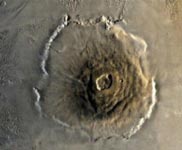Magma flow traced beneath three Martian volcanoes

Washington, Oct 18 : Scientists have traced the flow of magma beneath three large Martian volcanoes by comparing their surface features to those found on Hawaiian volcanoes.
“On Earth, the Hawaiian islands were built from volcanoes that erupted as the Earth's crust slid over a hot spot – a plume of rising magma. Our research raises the possibility that the opposite happens on Mars – a plume might move beneath stationary crust,” said Dr. Jacob Bleacher of Arizona State University and NASA's Goddard Space Flight Center in Greenbelt, Md.
Dr Bleacher said the observations could also indicate that the three Martian volcanoes might not be extinct.
The three volcanoes are in the Tharsis region of Mars, the same area as the giant Olympus Mons volcano, which with its 600 kilometres diameter, is the largest volcano in our solar system.
The new volcanoes, though smaller than Olympus (each is about 300 kilometres across), are still huge compared to terrestrial volcanoes. They form a chain heading northeast called the Tharsis Montes, from Arsia Mons just south of the Martian equator, to Pavonis Mons at the equator, to Ascraeus Mons slightly more then ten degrees north of the equator.
Though no volcanic activity has been observed at the Tharsis Montes, the scarcity of large impact craters in the region indicates that they erupted relatively recently in Martian history.
Features in lava flows around the Tharsis Montes reveal that later eruptions from large cracks, or rift zones, on the sides of these volcanoes might have started at Arsia Mons and moved northeast up the chain, according to the new research.
Using images and data from these missions, the team discovered that the main flanks of the Tharsis Montes volcanoes were all alike, with lava channels covering the few visible lava tubes.
However, each volcano experienced a later eruption that behaved differently. Lava issued from cracks (rifts) on the sides of the volcanoes, forming large lava aprons, called rift aprons by the team.
Observations further revealed that the rift apron on the northernmost volcano, Ascraeus Mons, had the most tubes, many of which were not buried by lava channels.
Since tube flows are the first to form over a hot spot, the researchers said, this indicated that Ascraeus was likely active more recently.
“The flow on the southernmost volcano, Arsia Mons, has the least tubes, indicating that its rift aprons are older. Also, the team saw more channel flows partially burying tube flows at Arsia,” said Dr Bleacher.
“These trends across the volcanic chain indicate that the rift aprons might have shared a common source like the Hawaiian volcanoes, and that apron eruptions started at Arsia, then moved northward, burying the earlier tube flows at Arsia with channel flows,” he said.
He said the team also did not see any cinder cone features on any of the Tharsis montes rift apron flows.
Since cinder cone eruptions are the final stage of hot spot volcanoes, the rift apron eruptions might only be dormant, not extinct, he said.
He said as volcanic eruptions released large amounts of greenhouse gasses, like carbon dioxide, into the atmosphere, if the eruptions were not complete, and future eruptions were large enough, they could contribute significant amounts of water and carbon dioxide to the Martian atmosphere.
Dr Bleacher is lead author of a paper on these results that appeared in the September 19 issue of the Journal of Geophysical Research, Planets. (ANI)